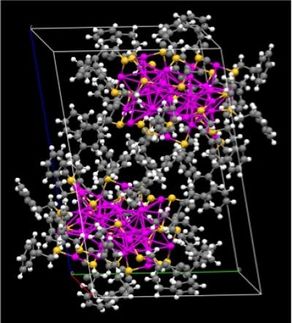Perfectly spherical gold nanodroplets produced with the smallest-ever nanojets
KU Leuven researcher Ventsislav Valev and an international team of scientists have developed a new method for optical manipulation of matter at the nanoscale. Using ‘plasmonic hotspots’ – regions with electric current that heat up very locally – gold nanostructures can be melted and made to produce the smallest nanojets ever observed. The tiny gold nanodroplets formed in the nanojets, are perfectly spherical, which makes them interesting for applications in medicine.
The ‘backjet’ phenomenon on which the method turns can be compared to a pebble being dropped into water. Tightly focused ultrafast laser pulses carry sufficient energy to locally melt the surface of a gold film. When a laser pulse of light hits the film, a nanoscale backjet – a nanojet – of molten gold surges upward.
As the name suggests, nanojets on the surface of a homogeneous gold film are incredibly small, their size being determined by the distribution of energy in the light pulse. This distribution of energy is in turn dependent on the wavelength of light. Initially, scientists anticipated that nanojets could not be significantly smaller than the wavelength of light. In this study however, Ventsislav Valev and his colleagues show that nanojets can in fact be made much smaller with the help of ‘plasmonic hotspots’.
Plasmonic hotspots are regions on the surface of metal nanostructures where light causes very strong oscillation of the electrons. Because electron oscillations constitute an electric current and because electric currents heat up the material the same way an electric stove heats up in the kitchen, the plasmonic hotspots are extremely hot. So hot that they can melt the gold in a spot much smaller than the wavelength of light. Dr. Valev and his colleagues were successfully able to demonstrate that this tiny little pool of molten gold can give rise to the smallest nanojets ever observed.
The gold nanodroplets propelled upward by the nanojets solidify in flight, producing perfectly spherical nanoparticles. These gold nanodroplets can be collected and used for medical applications including cancer treatment. The nanoparticles can be attached to molecules and injected in the blood. Once the molecules attach to cancer cells, light can be used to heat up the gold nanodroplets and destroy the cancer cells. Currently, the gold nanoparticles used in medications are chemically synthesised. These chemically synthesised gold nanoparticles have an unavoidably granular aspect. Conversely, gold nanodroplets created by the plasmonic nanojet method detailed by Dr. Valev and his colleagues are perfectly spherical, ensuring a better efficiency.
Original publication
Most read news
Original publication
Organizations
Other news from the department science
These products might interest you

NANOPHOX CS by Sympatec
Particle size analysis in the nano range: Analyzing high concentrations with ease
Reliable results without time-consuming sample preparation

Eclipse by Wyatt Technology
FFF-MALS system for separation and characterization of macromolecules and nanoparticles
The latest and most innovative FFF system designed for highest usability, robustness and data quality

DynaPro Plate Reader III by Wyatt Technology
Screening of biopharmaceuticals and proteins with high-throughput dynamic light scattering (DLS)
Efficiently characterize your sample quality and stability from lead discovery to quality control

Get the chemical industry in your inbox
By submitting this form you agree that LUMITOS AG will send you the newsletter(s) selected above by email. Your data will not be passed on to third parties. Your data will be stored and processed in accordance with our data protection regulations. LUMITOS may contact you by email for the purpose of advertising or market and opinion surveys. You can revoke your consent at any time without giving reasons to LUMITOS AG, Ernst-Augustin-Str. 2, 12489 Berlin, Germany or by e-mail at revoke@lumitos.com with effect for the future. In addition, each email contains a link to unsubscribe from the corresponding newsletter.

























































